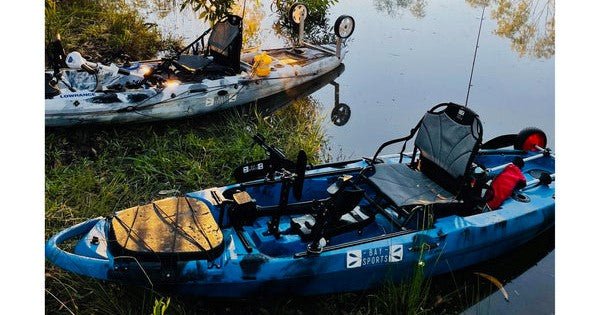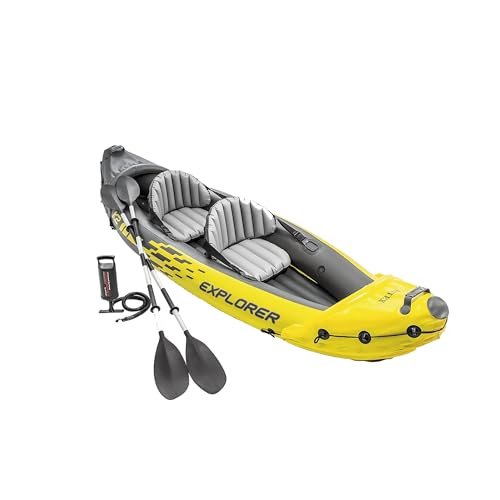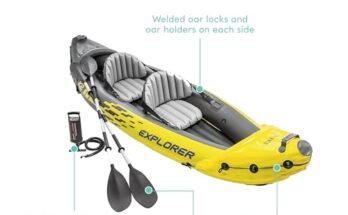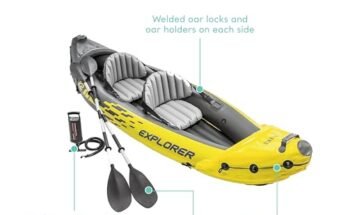Have you ever wondered how a pedal kayak moves so smoothly across the water while leaving your hands free? Understanding how a pedal kayak works can change the way you enjoy kayaking.
It’s not just about paddling anymore—your legs become the engine that powers your adventure. You’ll discover the simple mechanics behind pedal kayaks and why they might be the perfect choice for your next outing. Keep reading, and you’ll see how this clever design can make your time on the water easier, faster, and more fun.
Pedal Kayak Basics
Pedal kayaks use pedals instead of paddles to move through water. This lets you use your legs to power the kayak.
They are popular for fishing and exploring because they free your hands and provide steady movement.
What Is A Pedal Kayak
A pedal kayak is a small boat moved by pedaling with your feet. It has a pedal system linked to a propeller or fins under the kayak.
This system pushes the kayak forward or backward. You steer with a handle or a rudder controlled by your hands.
Types Of Pedal Kayaks
There are different pedal kayaks for various uses. Some focus on speed, others on stability or fishing features.
- Recreational Pedal Kayaks:Good for calm lakes and slow rivers.
- Fishing Pedal Kayaks:Designed with rod holders and storage spaces.
- Touring Pedal Kayaks:Built for long trips with more speed and comfort.
- Sit-on-Top Pedal Kayaks:Open tops for easy entry and exit.
Key Components
Pedal kayaks have several parts that work together to move and control the kayak.
- Pedal System:Includes pedals and gears to turn the propeller or fins.
- Propeller or Fins:Push water to move the kayak forward or backward.
- Rudder or Steering System:Controlled by a handle or foot pedals to steer the kayak.
- Hull:The main body that floats on water and holds the rider.
- Seat:Provides comfort and support for long rides.
Pedal Propulsion System
Pedal kayaks use a pedal system to move through the water. This system lets you use your legs to power the kayak. It frees your hands for other tasks like steering or fishing.
The pedal propulsion system works differently from traditional paddling. Instead of using arms, you pedal like on a bike. This method can be more efficient and less tiring.
How Pedals Power The Kayak
Pedal kayaks have pedals connected to a propeller or fins under the kayak. When you push the pedals, the propeller spins. This pushes water backward and moves the kayak forward.
Drive Mechanisms Explained
There are several ways pedal kayaks transfer power from pedals to water. The two most common drive types are chain drives and direct drives.
- Chain Drive:Pedals turn a chain, like on a bicycle. The chain spins the propeller. This system is flexible and easy to repair.
- Direct Drive:Pedals connect directly to the propeller shaft. This reduces parts and can be more efficient.
Advantages Over Traditional Paddling
| Advantage | Description |
| Hands-Free | You can use your hands while moving. |
| Less Arm Fatigue | Leg muscles are stronger and tire less quickly. |
| Better Speed | Continuous pedaling can maintain steady speed. |
| Improved Stability | Pedal system helps keep the kayak balanced. |
Steering And Control
Steering and control are key parts of using a pedal kayak. They help you move safely and smoothly on the water. You use different parts and techniques to guide the kayak.
Understanding how to steer and keep balance will make your kayaking experience better. Let’s look at some important parts and skills.
Rudder Operation
The rudder helps steer the kayak by changing its direction. It is controlled by foot pedals or a hand lever. Moving the pedals left or right turns the rudder the same way.
Using the rudder correctly reduces effort and keeps your kayak stable. It is best to adjust the rudder smoothly and avoid quick, sharp turns.
Turning Techniques
Turning a pedal kayak needs more than just the rudder. You also use your pedals and body weight to help the kayak turn well.
- Use the rudder pedals to start the turn.
- Pedal harder on one side to add power to the turn.
- Lean your body slightly toward the turn side for better balance.
- Keep your movements steady to avoid tipping.
Maintaining Stability
Keeping balance in a pedal kayak is very important. It prevents falls and helps you paddle longer.
| Tip | How to Do It |
| Keep your feet flat | Place both feet evenly on the pedals |
| Distribute your weight | Sit upright and center in the seat |
| Use your core | Engage stomach muscles to stay steady |
| Avoid sudden moves | Make slow, smooth adjustments |

Materials And Design
Pedal kayaks are designed for easy movement on water. Their materials and design affect speed and comfort.
Choosing the right materials and shape helps the kayak perform well and last longer.
Common Materials Used
Most pedal kayaks use plastic or composite materials. These materials are light and strong.
Plastic kayaks are affordable and easy to repair. Composite kayaks offer better speed and durability.
- High-density polyethylene (HDPE) is common for plastic kayaks.
- Fiberglass provides a smooth finish and good strength.
- Carbon fiber is light and very strong but costs more.
- Aluminum parts may be used in the pedal system for durability.
Hull Shapes And Impact
The shape of a pedal kayak’s hull affects how it moves through water. Different shapes suit different uses.
Long, narrow hulls move faster. Wider hulls are more stable but slower.
- Displacement hulls cut through water for smooth rides.
- Planing hulls rise on top of water at speed.
- Flat hulls offer high stability for beginners.
- V-shaped hulls improve tracking in waves.
Ergonomic Features
Ergonomic design makes pedaling easy and comfortable. It reduces strain during long trips.
Seats and pedals are shaped to fit the body and improve movement efficiency.
- Adjustable seats support the back and hips.
- Foot pedals have non-slip surfaces for safety.
- Handlebars and steering controls are easy to reach.
- Good legroom helps with smooth pedaling.
Choosing The Right Pedal Kayak
Pedal kayaks let you move hands-free on water. Picking the right one makes your trips better and safer.
Think about where and how you want to use the kayak before buying. This helps you find the best fit.
Matching Kayak To Activity
Different activities need different kayak types. Fishing kayaks have space for gear. Touring kayaks are fast and sleek. Recreational kayaks are stable and easy to use.
- Fishing: Choose kayaks with rod holders and storage.
- Touring: Look for speed and long-distance comfort.
- Recreational: Pick stable kayaks for calm waters.
Size And Weight Considerations
Kayak size affects speed and storage. Weight matters for transport and handling. A heavier kayak can be hard to carry but more stable in rough water.
| Size | Effect |
| Short (under 10 ft) | Easy to turn, less speed |
| Medium (10-14 ft) | Balanced speed and stability |
| Long (over 14 ft) | Higher speed, less maneuverable |
| Lightweight (under 50 lbs) | Easy to carry, less stable |
| Heavy (over 70 lbs) | Stable but harder to move |
Budget And Brand Options
Set a budget before looking at brands. Cheaper kayaks can be good for beginners. High-end brands offer more features and durability.
Consider these points:
- Check warranty and customer service.
- Read reviews for real user experiences.
- Compare included features and accessories.
- Think about local dealer support.

Maintenance And Care
Pedal kayaks offer a unique way to explore water bodies. Proper care extends their life and keeps them efficient.
Regular maintenance ensures smooth operation and prevents issues on the water. Here are some tips to help you maintain your pedal kayak.
Cleaning Tips
Keeping your kayak clean prevents damage and maintains its appearance. Follow these simple steps to clean your kayak:
- Rinse off salt and debris with fresh water after each use.
- Use mild soap and a soft brush for stubborn dirt.
- Check and clean the pedal mechanism regularly.
Storage Recommendations
Proper storage prevents damage from weather and prolongs the kayak’s life. Consider these recommendations:
| Storage Option | Description |
| Indoor | Store in a garage or shed to protect from elements. |
| Outdoor | Use a kayak cover to shield from sun and rain. |
| Rack | Place on a rack to avoid ground contact. |
Troubleshooting Common Issues
Even with good care, issues can arise. Here are some common problems and how to address them:
- Inspect the pedal system for wear and tear.
- Tighten any loose bolts or screws.
- Lubricate moving parts to ensure smooth operation.
Maximizing Performance
Pedal kayaks offer a unique way to explore the water. They use pedals instead of paddles to move. Understanding how they work helps you go faster and farther.
Learning proper techniques will improve your experience. This guide covers techniques, tips, and safety practices.
Paddling Techniques
Even with a pedal kayak, paddling skills matter. Use short, quick strokes to navigate tight areas. This helps keep your kayak steady.
When going straight, use long, smooth strokes. This keeps your kayak moving fast and straight.
- Short strokes for tight turns
- Long strokes for straight paths
- Keep your back straight for balance
Efficient Pedaling Tips
Pedal at a steady pace to save energy. Quick bursts can tire you out fast. Adjust the seat for comfort.
Use your legs and core muscles. This reduces strain on your knees.
- Pedal steadily to conserve energy
- Adjust seat for proper posture
- Engage core muscles while pedaling
Safety Practices
Always wear a life jacket. It is essential for safety. Check the weather before heading out.
Stay aware of your surroundings. Watch for boats and obstacles.
- Wear a life jacket
- Check weather conditions
- Be aware of surroundings

Frequently Asked Questions
What Mechanism Powers A Pedal Kayak?
A pedal kayak is powered by a pedal-driven system linked to a propeller or fins. When you pedal, the propeller rotates, propelling the kayak forward efficiently without using your hands.
How Does Steering Work In A Pedal Kayak?
Steering in a pedal kayak is controlled using a rudder system. The paddler uses a hand-operated or foot-operated control to turn the rudder, allowing easy directional changes while pedaling.
Are Pedal Kayaks Faster Than Traditional Kayaks?
Yes, pedal kayaks are generally faster because the leg muscles provide more power. Legs are stronger than arms, allowing sustained speed and less fatigue during long paddling sessions.
Can I Use My Hands While Pedaling A Kayak?
Yes, pedal kayaks free your hands from paddling duties. This allows multitasking like fishing, taking photos, or navigating while maintaining propulsion.
Conclusion
Pedal kayaks use your feet to move the boat forward. This lets your hands stay free for fishing or steering. The pedals turn a propeller or fins under the kayak. This method saves energy and helps you go faster. Pedal kayaks are easy to control and fun to use.
They work well in lakes, rivers, and calm seas. Understanding how they work makes your time on water better. Try one to see how smooth and simple paddling can be. Enjoy the ride and explore new places with ease.



